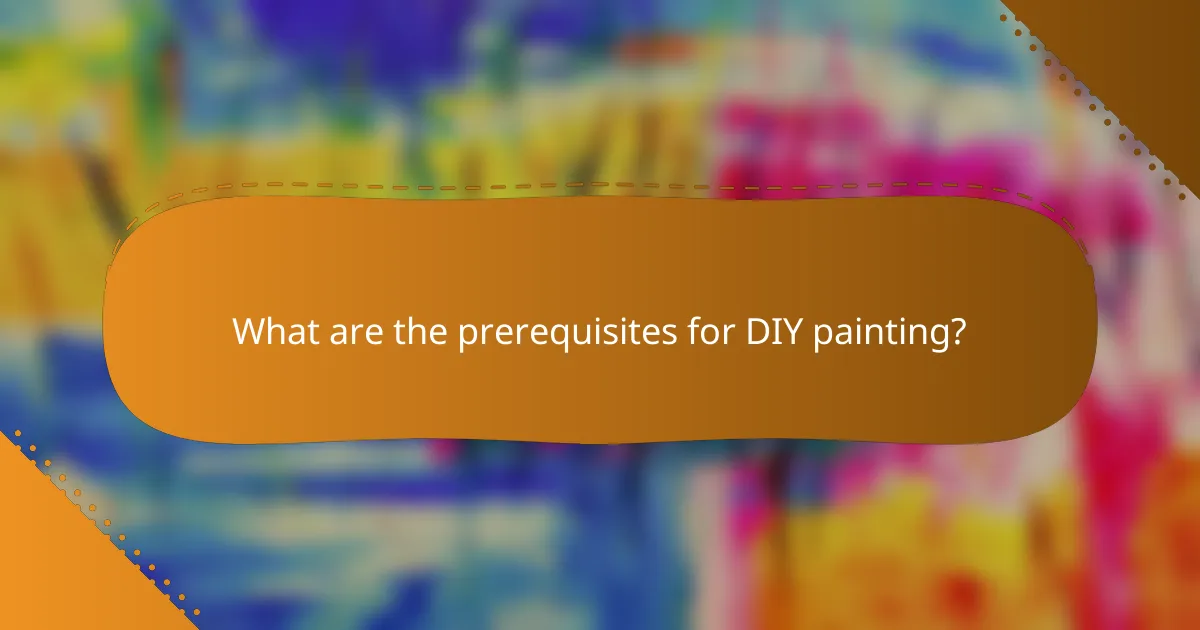Exploring various painting techniques can transform your DIY decor projects, offering a range of styles and finishes to suit your personal taste. From acrylic and watercolor to oil and spray painting, each method provides distinct effects that can enhance your living space. To achieve the best results, it’s essential to equip yourself with the right tools, such as brushes, rollers, and paint sprayers, ensuring a smooth and efficient painting experience.

What are the best painting techniques for DIY decor?
The best painting techniques for DIY decor include acrylic, watercolor, oil, spray painting, and stenciling. Each method offers unique finishes and effects, allowing you to customize your space according to your style and preferences.
Acrylic painting
Acrylic painting is a versatile technique that uses fast-drying paint made from pigment suspended in acrylic polymer emulsion. It can be applied to various surfaces, including canvas, wood, and walls, making it ideal for home decor projects.
This method allows for vibrant colors and can be used in techniques ranging from thick impasto to thin washes. To achieve different effects, consider using brushes, palette knives, or even sponges.
Watercolor techniques
Watercolor techniques involve using water-soluble pigments, which create soft, translucent effects. This method is particularly suited for delicate designs and subtle color transitions, making it perfect for decorative art pieces.
When working with watercolors, use high-quality paper and experiment with wet-on-wet or wet-on-dry techniques to achieve various textures. Keep in mind that watercolors can be less forgiving than other mediums, so practice is essential.
Oil painting methods
Oil painting methods utilize pigments mixed with oil, typically linseed, which allows for rich colors and a smooth finish. This technique is slower to dry, giving artists more time to blend and layer colors effectively.
For DIY decor, consider using oil paints for creating detailed artwork or textured effects. However, be aware that oil paints require proper ventilation and can take weeks to fully cure, so plan your projects accordingly.
Spray painting
Spray painting is a quick and efficient method for applying paint to surfaces. It involves using aerosol cans to create a smooth, even coat, making it ideal for larger areas or intricate designs.
When spray painting, ensure you work in a well-ventilated area and use drop cloths to protect surrounding surfaces. Layering is key; apply multiple thin coats rather than one thick coat to avoid drips and achieve a professional finish.
Stenciling
Stenciling is a technique that allows you to create precise designs by applying paint through a cut-out template. This method is excellent for adding patterns or motifs to walls, furniture, or other decor items.
To stencil effectively, secure the stencil in place and use a sponge or brush to apply paint lightly. Choose contrasting colors for a bold look or similar shades for a subtle effect. Always test on a small area first to ensure the desired outcome.

How do I choose the right paint finish?
Choosing the right paint finish is essential for achieving the desired look and durability in your DIY decor projects. Consider factors such as the room’s function, lighting, and the surface being painted to select a finish that meets both aesthetic and practical needs.
Matte finish benefits
Matte finishes offer a non-reflective surface that can hide imperfections well, making them ideal for ceilings and low-traffic areas. They provide a soft, elegant look and are often used in living rooms and bedrooms where a cozy atmosphere is desired. However, they can be less durable and harder to clean than other finishes.
Satin finish characteristics
Satin finishes strike a balance between matte and gloss, providing a subtle sheen that enhances color depth while remaining easy to clean. They are suitable for high-traffic areas like hallways and kitchens, as they resist stains and scuffs better than matte finishes. When choosing a satin finish, consider using it in spaces where both aesthetics and functionality are important.
Gloss finish advantages
Gloss finishes are highly reflective and durable, making them perfect for surfaces that require frequent cleaning, such as trim, cabinets, and doors. They can make colors appear more vibrant and are often used in modern designs for a sleek look. Keep in mind that gloss finishes can highlight surface imperfections, so proper preparation is crucial before application.

What tools do I need for painting projects?
For successful painting projects, you need a variety of tools tailored to your specific tasks. Essential tools include brushes, rollers, paint sprayers, and drop cloths, each serving a unique purpose to ensure a smooth and efficient painting process.
Brush types
Brushes come in various types, each suited for different applications. Common options include flat brushes for broad strokes, angled brushes for cutting in, and detail brushes for intricate work. Choose synthetic bristles for water-based paints and natural bristles for oil-based paints.
When selecting a brush, consider the size and shape that best fits your project. A 2- to 3-inch brush is ideal for walls, while smaller brushes work well for trim and corners. Always clean brushes thoroughly after use to maintain their longevity.
Roller specifications
Rollers are efficient for covering large areas quickly and come in various nap lengths, which affect the finish. A short nap (1/4 inch) is suitable for smooth surfaces, while a medium nap (3/8 inch to 1/2 inch) works well on lightly textured surfaces. For rough surfaces, opt for a long nap (3/4 inch or more).
When using rollers, pair them with a roller tray for easy loading and a roller extension pole for reaching high areas. Avoid overloading the roller to prevent drips and ensure an even application.
Paint sprayers
Paint sprayers provide a fast and even application, making them ideal for large projects or detailed work. There are airless sprayers, which are powerful and can handle thick paints, and HVLP (High Volume Low Pressure) sprayers, which are better for fine finishes and detail work.
Before using a sprayer, practice on a scrap surface to adjust the spray pattern and pressure. Ensure you wear protective gear, as overspray can be significant. Clean the sprayer thoroughly after each use to prevent clogs and maintain performance.
Drop cloths
Drop cloths protect your floors and furniture from paint splatters and spills. They come in various materials, including plastic, canvas, and paper. Canvas drop cloths are reusable and absorbent, while plastic ones are waterproof but can be slippery.
Choose a drop cloth that fits your project size and is durable enough to withstand foot traffic. Secure the edges with painter’s tape to prevent movement and ensure complete coverage during your painting project.

What are the prerequisites for DIY painting?
Before starting a DIY painting project, ensure you have the right tools, materials, and a clear plan. Understanding surface preparation, paint selection, and proper techniques will lead to a successful outcome.
Surface preparation steps
Proper surface preparation is crucial for achieving a smooth and durable finish. Start by cleaning the surface to remove dust, grease, and old paint. Use a mild detergent solution for walls and a degreaser for kitchen surfaces.
Next, repair any imperfections such as holes or cracks with spackle or filler, and sand the area once dry for an even texture. Finally, apply a primer if you’re painting over a dark color or a surface that might bleed through, as this will enhance paint adhesion.
Choosing the right paint
Selecting the appropriate paint is essential for both aesthetics and durability. Consider the type of finish you want: matte, satin, or gloss. Matte finishes are great for hiding imperfections, while gloss finishes are easier to clean and more durable.
Additionally, choose between water-based and oil-based paints. Water-based paints dry quickly and have low odor, making them suitable for indoor use, while oil-based paints offer a smoother finish and are better for high-traffic areas but take longer to dry. Always check for VOC (volatile organic compounds) levels to ensure safety, especially in enclosed spaces.

How can I enhance my painting skills?
To enhance your painting skills, practice regularly and explore various techniques and styles. Engaging in structured learning, such as online courses, can provide valuable insights and feedback.
Online courses
Online courses offer a flexible way to improve your painting skills from the comfort of your home. Many platforms provide structured lessons that cover different techniques, styles, and tools, allowing you to learn at your own pace.
When selecting an online course, consider your current skill level and specific interests. Look for courses that include video tutorials, assignments, and community feedback, which can enhance your learning experience. Popular platforms include Skillshare, Udemy, and Coursera, where you can find courses ranging from beginner to advanced levels.
Before enrolling, check for reviews and ratings to ensure the course meets your expectations. Some courses may offer free trials or money-back guarantees, allowing you to assess their value without financial commitment.


